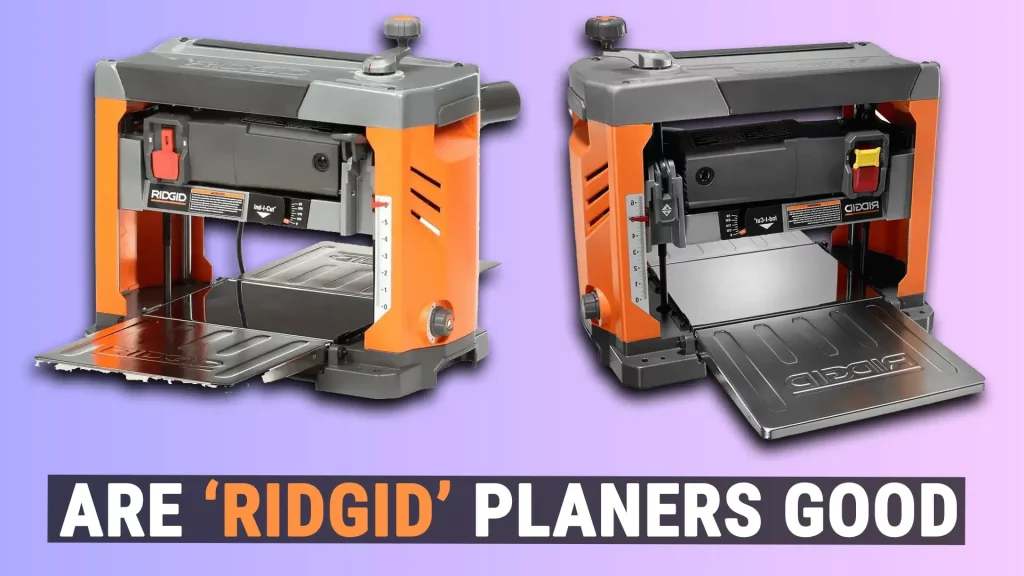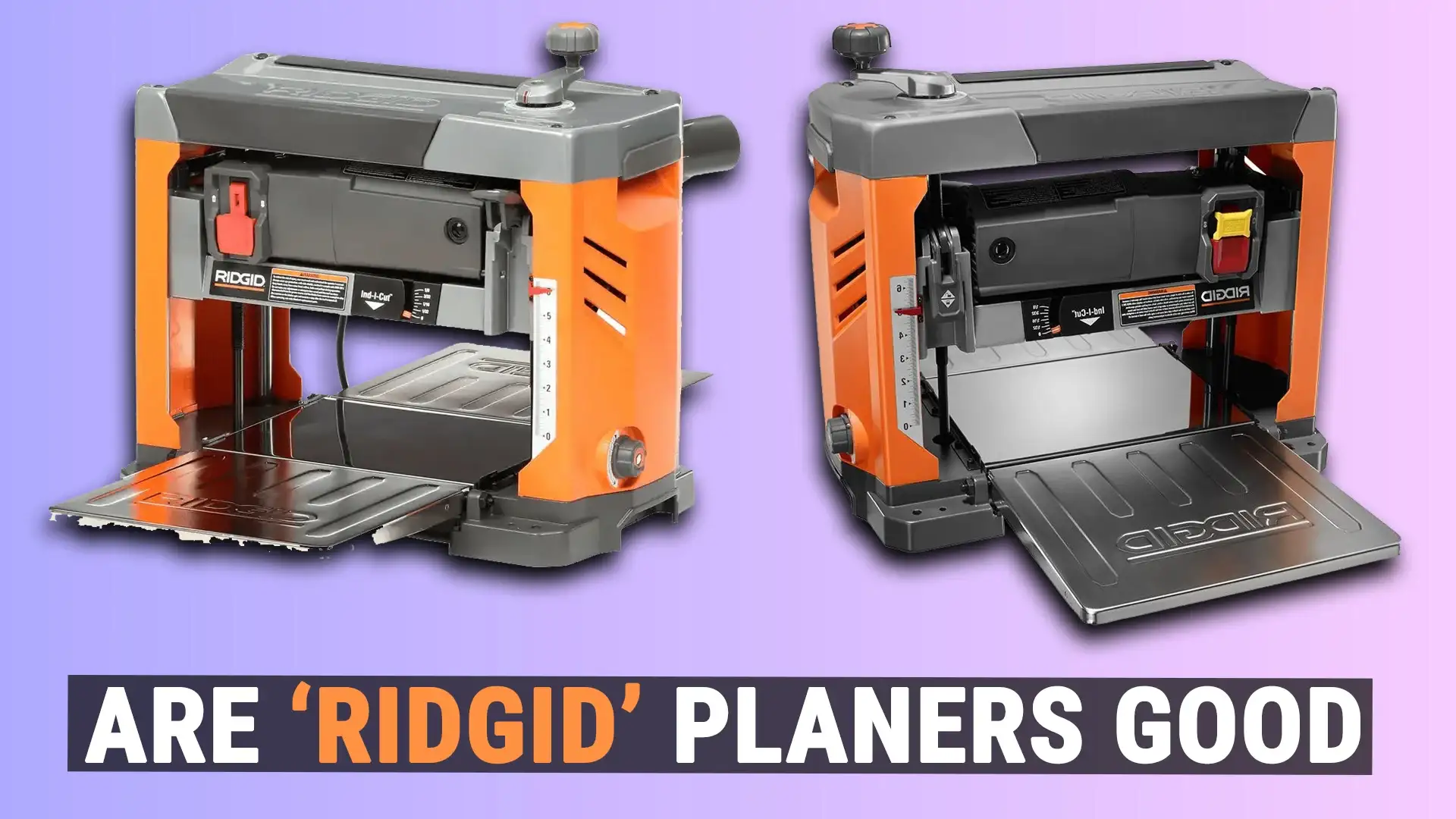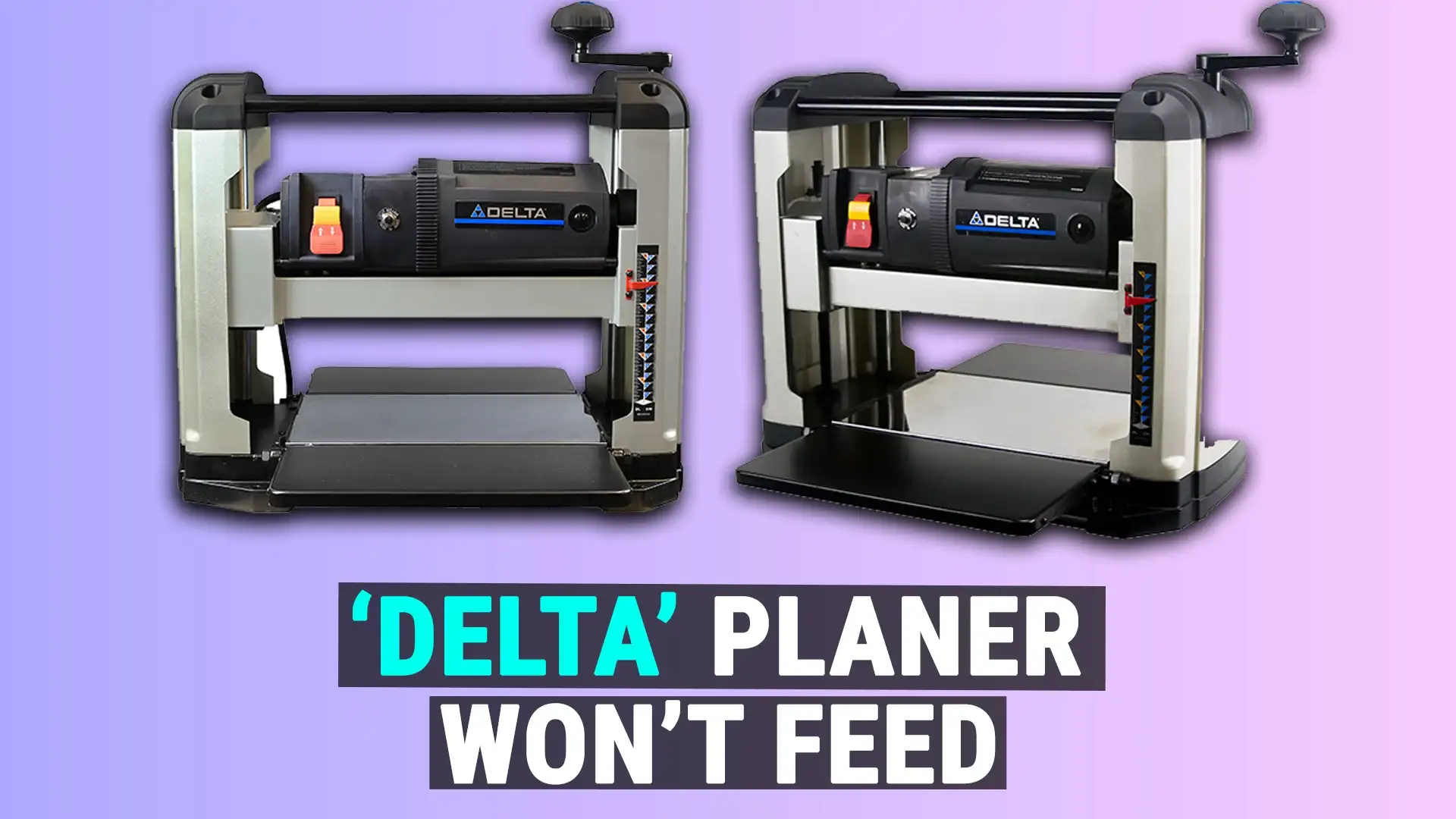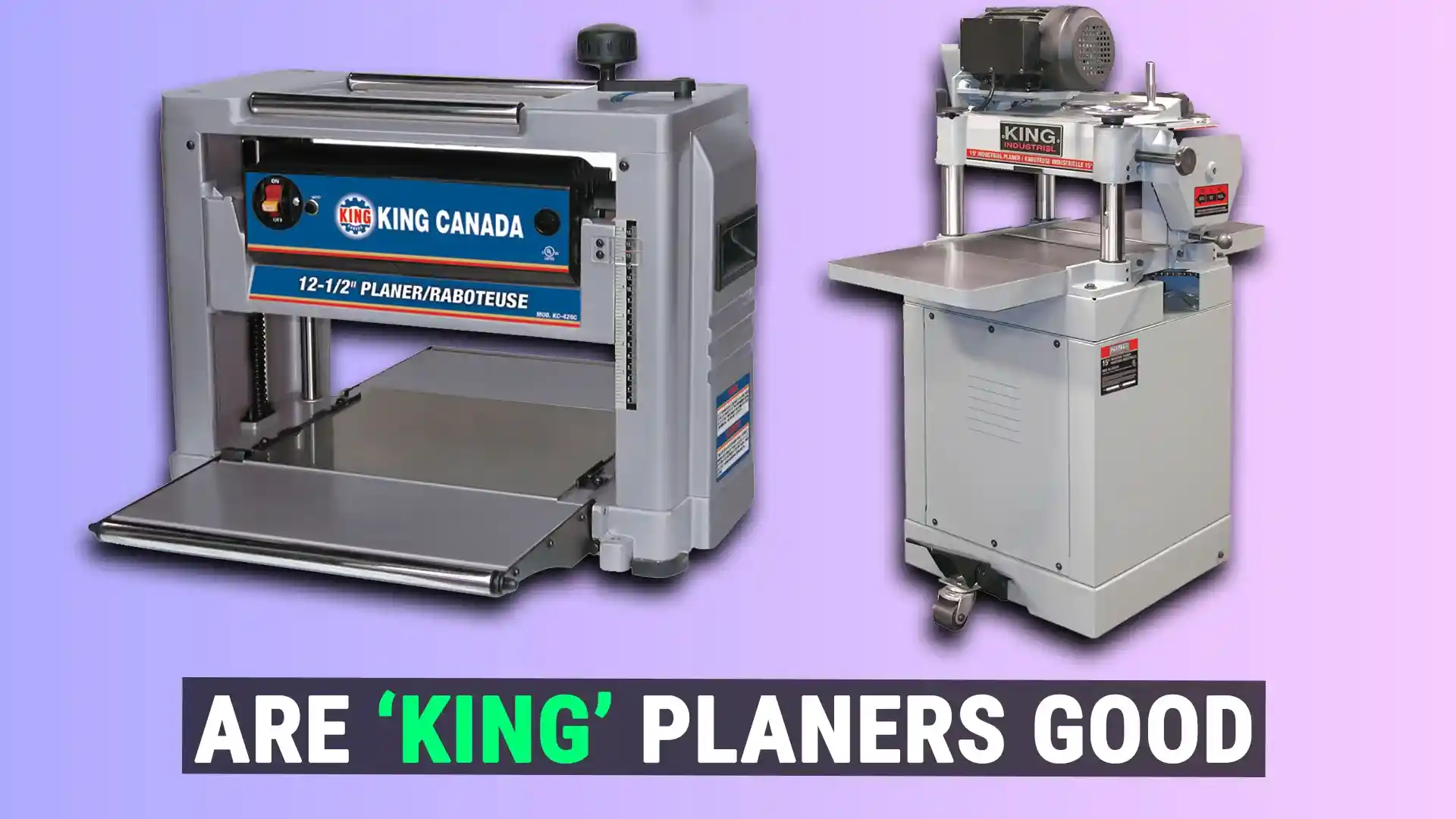Are Ridgid Planers Good? [2026]
Ridgid planers are a popular choice among both professional contractors and DIY enthusiasts for good reason. Ridgid has built a reputation for making high-quality and durable power tools. But how do their planers specifically stack up against competitors? Here is a comprehensive look at Ridgid planers, their key features, top models, pros and cons, and how they compare to other brands.

Overview of Ridgid Planers
Ridgid offers both benchtop and handheld planers for various applications. Their benchtop thickness planers are ideal for flattening, smoothing, and dimensioning lumber and boards. The handheld planers excel at trimming doors, smoothing edges, and detail work. Some key things to know about Ridgid planers:
- Power: They are equipped with strong motors (10-15 amps) that handle hardwoods with ease. This allows for smooth, even passes.
- Cuts: The cutterheads have two or three double-edged blades that create thousands of cuts per minute. The more cuts, the smoother the finish.
- Depth Capacity: They can plane boards up to 6 inches thick depending on the specific model. This allows dimensioning thick stock.
- Precision: They produce uniform cuts with precision ground tables that don’t snipe or lose level.
- Durability: Die cast materials, steel frames, and sturdy bases make them durable for shop use.
Top Ridgid Planer Models
Ridgid offers several benchtop and handheld thickness planer models to fit different needs and budgets. Here are some of their top options:
Ridgid R4331 13″ Benchtop Thickness Planer
- 3 knife cutterhead with 10,000 RPM
- Max cut depth of 6 inches
- Feed rate of 26 feet per minute
- Manual and automatic carriage locks
- Best for: Heavy duty smoothing, dimensioning, flattening
Ridgid R4330 Portable Thickness Planer
- 2 knife cutterhead with 96 cuts per inch
- Max cut depth of 1/8 inch
- Compact and portable design
- Best for: Job site use, trimming, smaller projects
Ridgid R21300 Handheld Planer Kit
- 1 5/64 inch maximum cut depth
- Two-blade cutter system
- 15 amp motor with 16,000 RPM
- Dust bag included
- Best for: Detail work, edges, quick touch ups
Pros of Ridgid Planers
There are several benefits that make Ridgid planers a high-quality option to consider:
- Powerful motors: The strong 10-15 amp motors allow for easy planning even with tough woods.
- Smooth finish: The 2-3 knife cutterheads make thousands of cuts per minute for a smooth finish.
- Noise reduction: Some models have noise dampening features for quieter operation.
- Durable construction: The metal components and sturdy bases withstand job site use.
- Portability: The handheld and some benchtops are lightweight for easy transport.
- Affordable pricing: They are competitively priced with other brands with similar features.
- 3-year warranty: All Ridgid tools come with an industry leading 3-year warranty for peace of mind.
Cons of Ridgid Planers
While Ridgid makes very solid thickness planers, there are a few potential downsides to consider:
- Limited feed speed: The feed rates top out at around 26 feet per minute, which is slower than some premium brands.
- Fewer cutterhead knives: Many only have 2-3 knives compared to 5+ on pricier models. More knives provide a smoother finish.
- Minimal snipe protection: Some users report snipe at the end of boards on certain models. Added outfeed support can help.
- No helical cutterheads: Ridgid has not yet released a model with a helical head, which leaves an extremely smooth finish.
- Dust collection could be better: Users note the dust ports could be more efficient in collecting chips. An aftermarket collector helps.
How Ridgid Compares to Other Brands
Ridgid planers offer great performance and features for the money compared to competitors. Here is how they stack up against some other top brands:
| Brand & Model | Price | Cutterhead | Thickness Capacity | Feed Rate | Motor Power
|-|-|-|-|-|-|
| Ridgid R4331 | $650 | 3 knife | 6 inches | 26 fpm | 15 amp
| Dewalt DW735X | $599 | 3 knife | 6 inches | 14 fpm | 15 amp
| Makita 2012NB | $619 | 2 knife | 6 inches | 16 fpm | 15 amp
| Delta TP305 | $729 | 2 knife | 3/4 inch | NA | 11.5 amp
| Grizzly G0505 | $745 | 2 knife | 12 inches | 28 fpm | 15 amp
As you can see, the Ridgid competes very well with these other popular benchtop models in power, cut depth, and overall quality. The main advantages of the pricier Delta and Grizzly models are their helical cutterheads for ultra-smooth planing. For most users, the Ridgid provides professional grade performance at a more affordable price point compared to premium brands.
Ideal Uses for Ridgid Planers
Thanks to their power and precision, Ridgid thickness planers are well suited for:
- Smoothing and flattening rough lumber
- Dimensioning boards to consistent thicknesses
- Trimming and squaring wood stock
- Facing boards for perfectly parallel faces
- Removing cupping, warping, or twisting
- Beveling edges
- Shaping wood by taking light passes
Whether you’re a furniture maker, carpenter, DIYer, or hobbyist woodworker, a Ridgid can tackle all of your planning needs for refined stock prep. They work well in woodshops, on job sites, or garages. The portable models allow for on-the-go convenience as well.
Tips for Using Ridgid Planers Effectively
To get the best performance possible from a Ridgid planer, keep these tips in mind:
- Carefully check lumber for nails, staples, or knots before planing to prevent cutterhead damage.
- Allow the planer to reach full speed before feeding in boards to maximize cutting efficiency.
- Take light passes of 1/32″ or less to reduce strain on the motor and produce a smoother finish.
- Advance the depth slowly when taking deep cuts to avoid bogging down the motor.
- Apply wax to the beds regularly for smoother board feeding.
- Rotate and index blades regularly for maximum cutting sharpness.
- Keep blades sharp – small nicks can affect cut quality.
- Clean out dust collection regularly to prevent clogging.
- Use proper infeed and outfeed support stands to reduce snipe.
Following those basic guidelines will help any Ridgid planer perform at its best.
Accessories for Enhancing Ridgid Planers
There are some handy accessories that can improve the performance and convenience of Ridgid planers:
- Additional extension tables – For supporting long boards on benchtop models.
- Caster wheels – Allows benchtop planers to be mobile in the shop.
- Infeed/outfeed stands – Helps support stock before and after the cut to prevent snipe.
- Replacement blades – Good to keep extras on hand for convenient blade changes.
- Aftermarket dust ports – Larger ports can improve dust collection.
- Power feeder attachment – Automatically feeds stock for hand-free operation.
Upgrading to a planer with those types of accessories can take your woodworking to the next level.
Best Uses for a Ridgid Benchtop Thickness Planer
Ridgid’s benchtop thickness planers like the R4331 13″ model are perfect for:
- Dimensioning rough lumber to consistent thicknesses
- Smoothing and flattening warped or twisted boards
- Trimming cupped boards flat along the face
- Squaring up edges and ends of boards
- Creating parallel faces on boards for joining
- Beveling edges and light profiling
- Fine trimming to sneak up on exact dimensions
A compact benchtop planer like the Ridgid R4331 is an extremely versatile woodworking power tool perfect for any home shop. It provides professional-level performance.
Best Uses for a Ridgid Handheld Planer
For detail work and on-the-go convenience, Ridgid handheld planers like the R21300 model excel at:
- Trimming and fitting doors
- Shaping wood edges
- Smoothing corners
- Removing high spots and imperfections
- Quick touch ups between major dimensioning
- Edge joining boards
- Detail planing of small projects
- Site work where moving lumber is difficult
Handheld planers are designed for portability and ease of use for trim applications where a benchtop isn’t practical. Ridgid’s handheld planers are rugged enough for daily job site use.
Is a Ridgid Planer Worth the Investment?
For most woodworkers, a Ridgid thickness planer is absolutely worth the investment. Here’s a recap of the key benefits they offer:
- Professional grade power and performance
- Smooth, even planing from 2+ knife cutterheads
- Ability to flatten, straighten, and dimension lumber
- Precise cuts with minimal snipe
- Quiet operation compared to competitors
- Very durable construction for years of use
- Lifetime service agreement from Ridgid
For the price, Ridgid offers some of the best value you can find in portable and benchtop planers. While more premium brands have extra features like helical cutterheads, for most hobbyists and professionals the Ridgid models provide all the power, precision, and performance you need in a planer. The money saved can be put towards acquiring other important shop tools.
Final Thoughts on Ridgid Woodworking Planers
When it comes to thickness planers, Ridgid delivers outstanding power, solid capability, and reliability that competes with far more expensive machines. For anyone from DIYers to professional carpenters looking for quality planing without breaking the bank, Ridgid models like the R4331 and R21300 represent a sweet spot of price, performance and durability. Their proven track record and 3-year warranty provide peace of mind your investment will deliver years of smooth planing. So if you’re wondering “are Ridgid planers good?”, the answer is a resounding yes. They provide advanced features and smooth precise planing at a very appealing price point.



